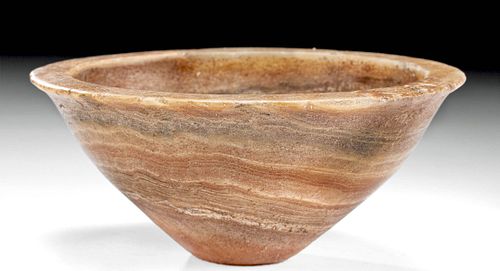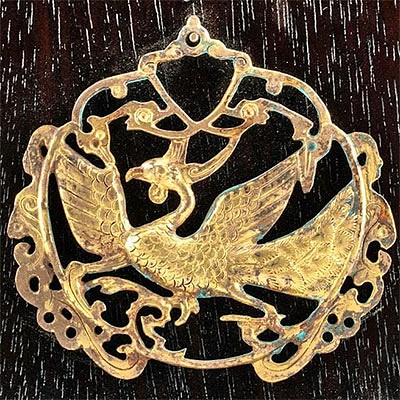Bactrian / BMAC Banded Alabaster Shallow Bowl
Lot 62
About Seller
Artemis Fine Arts
686 S Taylor Ave, Ste 106
Louisville, CO 80027
United States
Selling antiquities, ancient and ethnographic art online since 1993, Artemis Gallery specializes in Classical Antiquities (Egyptian, Greek, Roman, Near Eastern), Asian, Pre-Columbian, African / Tribal / Oceanographic art. Our extensive inventory includes pottery, stone, metal, wood, glass and textil...Read more
Categories
Estimate:
$2,500 - $3,500
Absentee vs Live bid
Two ways to bid:
- Leave a max absentee bid and the platform will bid on your behalf up to your maximum bid during the live auction.
- Bid live during the auction and your bids will be submitted real-time to the auctioneer.
Bid Increments
| Price | Bid Increment |
|---|---|
| $0 | $25 |
| $300 | $50 |
| $1,000 | $100 |
| $2,000 | $250 |
| $5,000 | $500 |
| $10,000 | $1,000 |
| $20,000 | $2,500 |
| $50,000 | $5,000 |
| $100,000 | $10,000 |
| $200,000 | $20,000 |
About Auction
By Artemis Fine Arts
Jun 17, 2021
Set Reminder
2021-06-17 10:00:00
2021-06-17 10:00:00
America/New_York
Bidsquare
Bidsquare : Ancient & Ethnographic Art Through The Ages
https://www.bidsquare.com/auctions/artemis-gallery/ancient-ethnographic-art-through-the-ages-7094
Ancient art from Egypt, Greece, Italy and the Near East, as well as Asian, Fossils, Pre-Columbian, Native American, African / Tribal / Oceanic, Fine art, and much more! All categories, all price ranges... all legally acquired and guaranteed to be as described or your money back. Artemis Fine Arts info@artemisgallery.com
Ancient art from Egypt, Greece, Italy and the Near East, as well as Asian, Fossils, Pre-Columbian, Native American, African / Tribal / Oceanic, Fine art, and much more! All categories, all price ranges... all legally acquired and guaranteed to be as described or your money back. Artemis Fine Arts info@artemisgallery.com
- Lot Description
Central Asia, modern day Pakistan / Afghanistan, Bactria (Bactria-Margiana / BMAC), ca. 3rd to 2nd millennium BCE. A gorgeous shallow dish carved from alabaster on a small circular textured base with thin walls expanding outward to a rounded body and flared rim. Naturally adorned in bands of caramel, sand, buff, and cream, this stunning bowl boasts a lovely iridescence in the sunlight. Alabaster, a light-colored, calcareous stone from the Iranian Plateau, has strong connections in ancient western and central Asia to religion. For example, in the site of Kultepe-Kanes, a huge burial mound, there were many disc-shaped alabaster idols, naked alabaster goddesses, and lion figures. We also know that alabaster was a precious material, widely traded in the region from the 4th millennium BCE onward. A dish like this one was likely made to be placed into a tomb to hold offerings. A beautiful vessel from early Bactria! Size: 6.26" W x 3.125" H (15.9 cm x 7.9 cm)
Provenance: Paul Henderson collection, Los Angeles, California USA from the private Oxford collection; previously in an old British collection, formed in the 1980s on the UK / International art markets
All items legal to buy/sell under U.S. Statute covering cultural patrimony Code 2600, CHAPTER 14, and are guaranteed to be as described or your money back.
A Certificate of Authenticity will accompany all winning bids.
We ship worldwide and handle all shipping in-house for your convenience.
#159521A few internal stable hairline fissures, nicks, chips, and abrasions, most notably on rim, commensurate with age and use. Otherwise, intact and excellent.Condition
- Shipping Info
-
All shipping is handled in-house for your convenience. Your invoice from Artemis Gallery will include shipping calculation instructions. If in doubt, please inquire BEFORE bidding for estimated shipping costs for individual items.
-
- Buyer's Premium



 EUR
EUR CAD
CAD AUD
AUD GBP
GBP MXN
MXN HKD
HKD CNY
CNY MYR
MYR SEK
SEK SGD
SGD CHF
CHF THB
THB
















